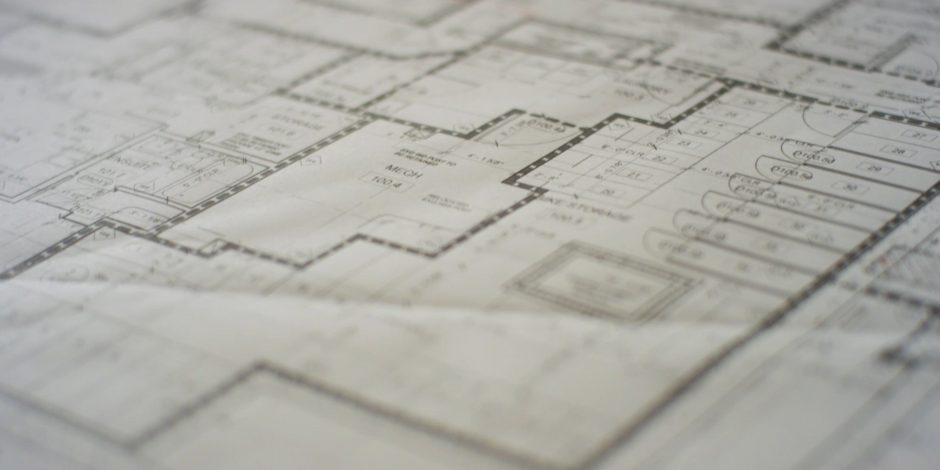Office Building Construciton Plan Drawing
Eight types of construction drawings used in commercial structure
April 09, 2021

Blueprints, plans, drawings—in construction, these three terms all refer to the aforementioned matter. These are technical drawings created by architects, engineers, and designers to represent the vision for a construction project, and act equally a roadmap for making it a reality.
Professional carpenter Elly Hart explains in her class on reading commercial blueprints, "Construction blueprints aren't just drawings—they're a contract that represents what's going to be built, and it'south a critical course of advice that gets everybody involved on the same page. It'south the one shared goal for all the different trades on site."
eight Types of structure drawings
There are eight main types of construction drawings included in a set of commercial blueprints. The same types of drawings also appear in residential construction, just their scope and specific contents will differ. Elly Hart explains:
"On commercial projects, blueprints are typically separated past discipline. The architectural drawings are separate to the structural drawings, which are separate to the mechanical drawings, and and then on. A complete set of IFCs will ofttimes contain hundreds and hundreds of sheets. There volition often be multiple floors, multiple sets of stairs, multiple components that look the same simply accept important differences depending on their purpose and location, and they all demand to be uniquely identifiable on the plans."
Beneath is a detailed description of each type of construction drawing you lot'll encounter in a set of commercial blueprints.
Site Plans
Site plans are a type of architectural drawing that functions every bit a map of a edifice site, giving y'all the details you need to know nearly how the structure will be oriented on the lot. An architect will create a diagram that shows the plot of land and its property lines, along with its landscape features, setbacks, driveways, utility poles and power lines, fencing, and on-site structures.
Floor Plans
A flooring plan is a bird'south eye view of a building, giving you a detailed pic of the layout of each flooring. Information technology includes features such every bit walls, doors, windows, means of egress, and sometimes even furniture.
Reflected Ceiling Plans (RCP)
The RCP is a impress that shows you the dimensions, materials, and other primal information nigh the ceiling of each of the rooms represented on your blueprint. It takes its name from the thought that you are looking downwardly at the ceiling as though there were a mirror on the flooring reflecting the ceiling's program back to you.

Sections
While a floorplan gives a horizontal view of a floor in a building, sections give a vertical view. A sectional view shows the floor elevations, ceiling heights, and structure details such every bit fire separations. While a floor plan allows for a view of how the walls stand in relation to each other, a section shows where the wall meets the floor, and the altitude that separates one flooring from another. Sections besides provide a better understanding of how a building's spaces volition arrange its time to come occupants and whether, for example, the ceiling will feel like it looms or soars overhead.

Structural Drawings
Engineers create structural drawings to show how the edifice will be framed, and how information technology will be given its structure. Yous'll meet a structural cartoon for each floor of the building, including floors below grade such as parkades and storage.
Mechanical, Electrical, and Plumbing (MEP) Drawings
MEP drawings testify the key nervous system of a edifice. Describing these functions, from ensuring its air quality to planning its electronic and communications systems, to laying out complex piping routes, is the responsibility of MEP engineers.
- The mechanical plans show the heating, ventilation, and air-conditioning (or HVAC) systems of a edifice.
- The electrical plans evidence how the electrical system volition provide the power supply for lights and appliances, every bit well as access control and fire alarm systems. Electric engineers design the routes for wiring and so they can be safely and continuously operated.
- Plumbing plans reflect the complex pipe and sewage routes for the edifice, equally well as heated water and rainwater drove and storage.
Schedules
Schedules are drawings showing supplementary information, typically presented in tables, that go across the details that can be found on the floor plans. Window and door schedules provide the additional information that a contractor will demand in lodge to install these items: the dissimilar types of windows and doors to exist used in a edifice, their locations, and the hardware and finishes to be used with each of them. There are oft split up hardware and stop schedules besides as fixtures and equipment schedules.

Detail Drawings
Special details of a edifice are included in drawings whose features are magnified so that a architect can see how to construct these elements. Structural connections, stairs, means of egress, and wall junctions tin all be included in supplemental particular drawings.
MT Copeland offers video-based online classes that give you a foundation in construction fundamentals with real-world applications, like building cabinets .
Classes include professionally produced videos taught by practicing craftspeople, and supplementary downloads similar quizzes, blueprints, and other materials to assistance you main the skills.
Source: https://mtcopeland.com/blog/eight-types-of-construction-drawings-used-in-commercial-construction/
0 Response to "Office Building Construciton Plan Drawing"
Post a Comment